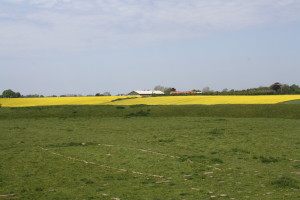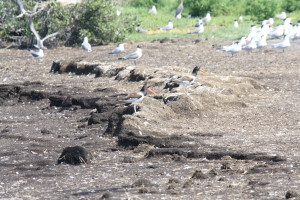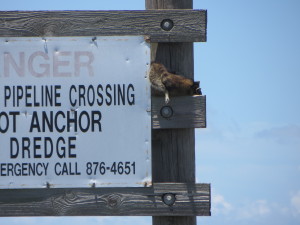In my last post, I looked at the consequences of habitat fragmentation when we build roads or dams or other physical structures- we construct barriers that are useful to us, but not so helpful to the plant and animal populations we isolate. And sometimes we create obstacles to movement even when we think we’re making small changes. One of the most important elements of habitat fragmentation is what we call the matrix, the environment directly around the fragments- when we replace habitat with roads, it’s pretty obvious that we’ve drastically altered the environment and created a hostile matrix; but changes don’t have to be that profound to have a big impact.

The yellow flowers are in a tilled field- pretty to look at, but not really offering a lot to wildlife
Think about driving through an area filled with farms- we might see pastures, tilled fields, streams bordered by thick vegetation, or forest patches. While it might look like there is plenty of space for plants and animals of all kinds and no shortage of vegetation, the reality is that many species do not thrive in habitats that have been manipulated by humans. But don’t the fields provide food sources and vegetative cover? Well, it depends on what you mean by that. Certainly we gain food from the fields and pastures, and it’s true that animals aren’t as visually exposed on farmland as on, say, tarmac, but we’ve replaced the natural environment with something considerably more artificial, leaving some species out in the cold. A study on common toads in Europe, for example, found that toads were able to move much more easily through woodland and meadows than through cropland (Janin et al. 2009)- intensive agriculture creates environments with less water content and more chemicals, neither of which is good for amphibians. Researchers in the Czech Republic found that carnivores were much more likely to stay in the long grasses and shrubs bordering hayfields than to venture into the fields themselves (Salek et al. 2009)- this could be because they feel more at risk in the fields or because the prey they seek prefers more vegetative cover. This situation applies to forests as well- more species of longhorn beetle were found in natural forest when compared with cedar planted forests in Japan (Yamaura et al. 2011), and arboreal mammals in Australia did not disperse through pine plantations above a certain distance even though there were still tall trees to climb ( Lancaster et al. 2011). Either way the message is clear: all vegetation types are not equal. As a result of replacing forest with meadow or grassland with subdivision or hedgerows (originally left in place to mark the edges of fields) with more cropland, species that depend on the microclimates created within more complex habitat find themselves encircled or even excluded by the matrix- in the UK, for example, hedgehog numbers have declined systematically as large-scale agriculture consolidated fields and removed hedgerows (Robinson & Sutherland 2002). Researchers have also found that pollination can be negatively impacted by habitat fragmentation, for example when pollinating insects must cross large fields of corn to get to the next patch (Van Geert et al. 2010).

These birds nest on what once was a much larger island- as you can see, tidal and storm erosion are eating away at their habitat, a bit at a time
We’re fragmenting aquatic systems as well, which is something that I have seen quite a bit of here in Louisiana. We may remove aquatic vegetation when boats and their propellers hit the bottom- you might say that, since it’s in water, the fish or crustaceans can simply swim to the next patch, but remember that entering open water may be a very risky undertaking if predators are near. To get to some of the islands I work on, we follow dredged canals created to facilitate shipping- it breaks up the marsh, leading to altered water flows which can increase erosion (Wilson et al. 2007), and once again open water can be a real problem to cross. Sometimes we also pile the dredged material on either side of the canals, creating earthen barriers that aquatic organisms can’t cross (Haas et al. 2004). Animals left out on the islands of marsh may find themselves increasingly isolated, especially as sea levels rise. I find it sad to think that we’re creating something of a no-win situation for these populations- not only are we directly using some of their previous habitat, but our activities are also steadily limiting their options for responding to change.

I found these two raccoons sleeping in the sun on a pipeline sign in the canal- I know they can swim back to dry land, but I also know that there are bigger creatures than raccoons hanging out in the canal
There are different ways that we create fragmented habitat- sometimes it’s a clear, hard line, and sometimes the new habitat might look similar to what was there before but be fundamentally different underneath the surface. Luckily, there are also many studies looking into what can be done to mitigate isolation and keep these animals and plants moving throughout the landscape- for my final post of the month, I’ll have a range of suggestions for how you can keep the lanes of travel open.
Works cited:
Haas, HL, Rose, KA, Fry, B, Minello, TJ, and LP Rozas. 2004. Brown shrimp on the edge: linking habitat to survival using an individual-based simulation model. Ecological Applications 14: 1232-1247.
Janin, A, Lena, J-P, Ray, N, Delacourt, C, Allemand, P and P Joly. 2009. Assessing landscape connectivity with calibrated cost-distance modelling: predicting common toad distribution in a context of spreading agriculture. Journal of Applied Ecology 46: 833-841.
Lancaster, ML, Taylor, AC, Cooper, SJB, and SM Carthew. 2011. Limited ecological connectivity of an arboreal marsupial across a forest/plantation landscape despite apparent resilience to fragmentation. Molecular Ecology 20: 2258-2271.
Robinson, RA and WJ Sutherland. 2002. Post-war changes in arable farming and biodiversity in Great Britain. Journal of Applied Ecology 39: 157-176.
Salek, M, Kreisinger, J, Sedlacek, F, and T Albrecht. Corridor vs. hayfield matrix use by mammalian predators in an agricultural landscape. Agriculture, Ecosystems and Environment 134: 8-13.
Van Geert, A, Van Rossum, F, and L Triest. 2010. Do linear landscape elements in farmland act as biological corridors for pollen dispersal? Journal of Ecology 98: 178-187.
Wilson, MD, Watts, BD, and DF Brinker. 2007. Status review of Chesapeake Bay marsh lands and breeding marsh birds. Waterbirds 30: 122-137.
Yamaura, Y, Taki, H, Makihara, H, Isono, M, Fujita, Y, and K Okabe. 2011. Revisitation of sites surveyed 19 years ago reveals impoverishment of longhorned beetles in natural and planted forests. Entomological Science 14: 56-67.
